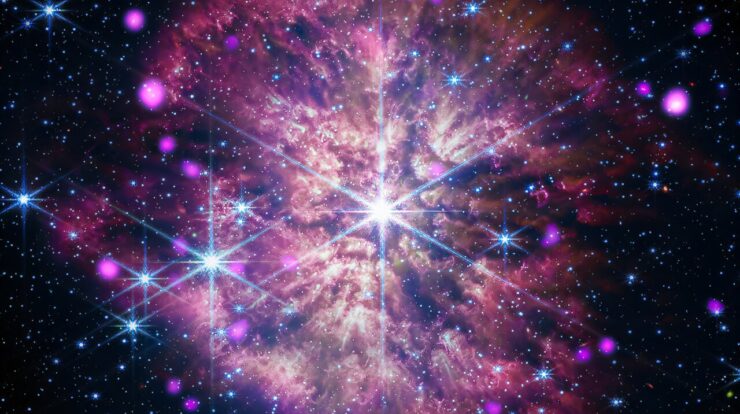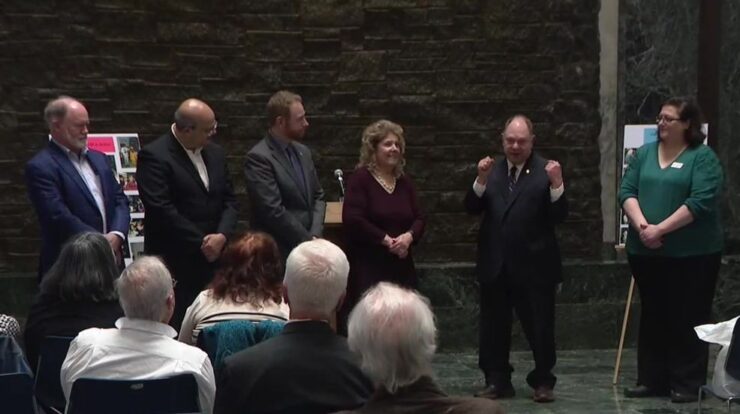
NASA has unveiled three new audio representations of phenomena related to some of the most mysterious objects in our cosmos: black holes. These creations are known as sonifications—conversions of data gathered by various NASA observatories into audible form. The datasets were captured using instruments such as the Chandra X-ray Observatory, the James Webb Space Telescope, and the Imaging X-ray Polarimetry Explorer (IXPE).
These three newly created audio representations depict various facets of black holes. Black holes are not constant or uniform entities; they change over time and can be encountered across a spectrum of dimensions and settings.
WR 124
The initial segment serves as a precursor to the possible formation of a black hole. WR124 is a remarkably luminous, brief-living giant star classified as a Wolf-Rayet located roughly 28,000 light-years away from our planet. Such stars expel their external layers into the cosmos, resulting in magnificent configurations captured in an infrared photograph taken by the Webb telescope.
During the sonification of WR124, the nebula is represented by flute notes, while the surrounding stars sound like tinkling bells. The scanning process starts at the heart of WR124, which houses an intensely hot stellar core; this core could eventually go supernova, possibly resulting in the formation of a black hole afterward. As the scan progresses from the central region outwards, X-ray emissions identified by the Chandra telescope are converted into melodic harp tones.
Data from NASA’s James Webb Space Telescope is heard as metallic bell-like sounds, while the light of the central star is mapped to produce the descending scream-like sound at the beginning. The piece is rounded out by strings playing additional data from the infrared telescopic trio of ESA’s (European Space Agency’s) Herschel Space Telescope, NASA’s retired Spitzer Space Telescope, and NASA’s retired Wide Image Survey Explorer (WISE) as chords.
SS 433
In the second segment of this cosmic symphony centered around a black hole, audiences can delve into a duo performance. Located approximately 18,000 light-years from Earth, SS 433 emits signals detectable in X-ray frequencies. Comprising SS 433 are two celestial bodies: one akin to our Sun and another significantly more massive, which could be either a neutron star or a black hole. Their mutual revolution generates fluctuations in X-ray emissions that space observatories such as Chandra, IXPE, and ESA’s XMM-Newton are calibrated to capture.
The X-ray observations have been integrated with radio and infrared information to create a visual foundation for this cosmic ballet. In radio wavelengths, the nebula looks like a floating sea cow, and the scanning process moves from right to left. Higher pitches represent light at the upper part of the image, whereas radio, infrared, and X-ray emissions correspond to lower, middle, and higher tones respectively. Prominent background stars emit sounds akin to dripping water, while the position of the binary star system produces a plucking noise that fluctuates according to their orbital movements.
Centaurus A
In the last and concluding segment of the sonification series inspired by black holes, the composition reaches its peak with sounds originating from Centaurus A, which lies approximately 12 million light-years from our planet. This galaxy houses a massive black hole at its core, emitting powerful jets that traverse the whole expanse of the galaxy. As you move clockwise starting from the upper part of the visualization, each encounter with data captured by Chandra produces tones reminiscent of individual wind chime notes.
X-ray light from IXPE is heard as a continuous range of frequencies, producing a wind-like sound. Visible light data from the European Southern Observatory’s MPG telescope shows the galaxy’s stars that are mapped to string instruments, including foreground and background objects as plucked strings.
More information:
For more NASA sonifications and information about the project, visit
chandra.si.edu/sound/
Provided by NASA
This tale was initially released on
Dailyexe
. Subscribe to our
newsletter
For the most recent science and technology news updates.






